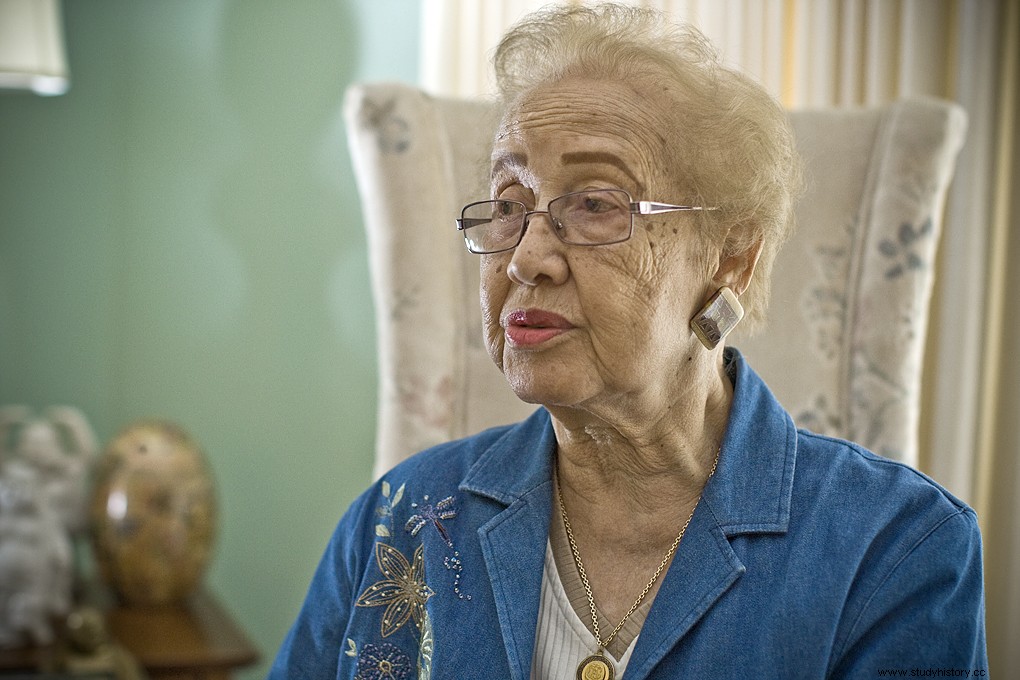Katherine Coleman Goble Johnson (1918 – 2020) was an American mathematician and astrophysicist. Working for NASA, she participated in American space programs, notably by calculating the trajectory of the Mercury program and the Apollo 11 mission.
Exceptional intelligence

Katherine Coleman was born on August 26, 1918 in White Sulfur Springs (West Virginia, USA). His parents, Joylette, a teacher, and Joshua, a farmer, have four children. Katherine very quickly shows exceptional intelligence. At the age of four, while her parents are spelling certain words that they do not want her to understand, she lets them know that she can spell. At school, she is gifted and passionate about mathematics. In the midst of segregation, Katherine and her siblings attend schools for black students only.
At the time, the county on which it depends did not consider it necessary to offer an education to black children beyond the age of nine or ten. But education is very important to the Colemans, who send their children to Institute, a high school reserved for black students. Katherine obtained her diploma (equivalent to the baccalaureate) at fourteen before going to West Virginia State University (English), also segregated. She takes all the math classes she can; one of her professors, William Claytor (one of the first African Americans to earn a thesis in mathematics) even created new courses especially for her. Katherine graduates in Maths and French summa cum laude (the highest distinction) at the age of 18.
In 1939, Katherine married James Francis Goble, with whom she had three daughters:Constance, Joylette, and Katherine. After the death of her husband in 1956, she remarried in 1959 to Lieutenant-Colonel James A. Johnson.
“Computers in skirts”
After graduating, Katherine Johnson moved to Marion, Virginia, to teach math, French, and music at a segregated elementary school. Teaching did not satisfy her, and she considered a career in mathematics. During a family reunion, a relative informed him that the National Advisory Committee for Aeronautics (NACA, future NASA), recruits and looks for African-American women in particular. In 1953, she obtained a position in a team of women in charge of mathematical calculations, which she described as "computers in skirts". She and her colleagues are tasked with reading data from airplane black boxes and performing precise mathematical calculations. One day, Katherine and a co-worker are temporarily assigned to an all-male flight search team. Her knowledge and skills in mathematics quickly made her indispensable, and Katherine remained with her new team. Unaware of the racism and sexism of which she is the victim, she imposes her presence in meetings that no woman has ever attended and asserts her legitimacy by recalling that she "does the job".
Apollo 11
Until 1958, Katherine Johnson carried out cutting-edge analytical work on subjects related in particular to aircraft aerodynamics. From 1958 until her retirement 25 years later, she worked as an aerospace engineer. In 1959, it was she who calculated the trajectory of the space flight of Alan Shepard, the first American sent into space during the Mercury program, which took off two years later. It is also she who calculates the launch window (optimal period for the launch of a rocket) of this mission. In 1962, when NASA first used computers to calculate an orbit around the Earth, Katherine was asked to verify the results. Thereafter, she will work with computers. In 1969, she calculated the trajectory of the Apollo 11 mission to the Moon. She also works on the Apollo 13 Mission; when she fails, she helps the crew return to Earth by working on procedures and charts. Later in her career, she also worked on the Space Shuttle program and on plans for a mission to Mars.
For her entire career and her role as a pioneer in the field of astrophysics, Katherine Johnson has received numerous honors and awards. In November 2015, she was notably awarded the Presidential Medal of Freedom, the highest civilian honor in the United States.
Katherine Johnson died in February 2020, at the age of 101.
